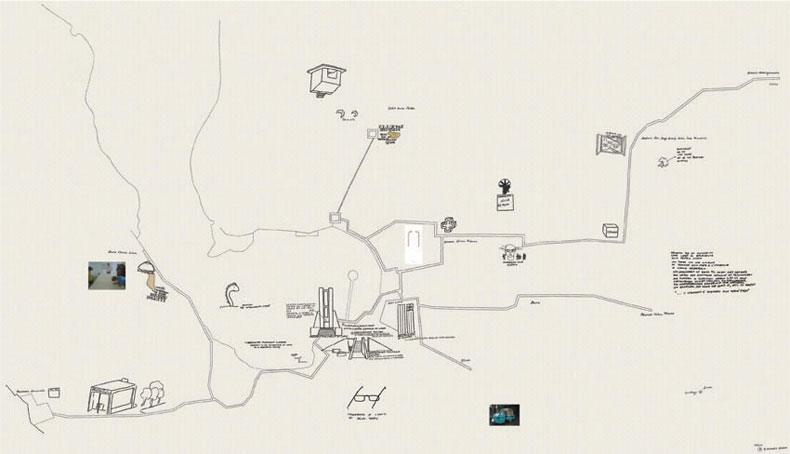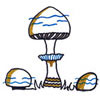Monologo Needle work on cotton, embroidered by hand,150 x 300 cm, 2009. |
 |
"Gedanken zu Denkm Their view; it is cosmic. Not a man here, a child there, but an abstraction: race, land. Volk. Land. Blut. Ehre. Not of honourable men but of Ehre itself, honour; the abstract is real, the actual is invisible to them. Die Güte, but not good man, this good man. It is their sense of space and time. They see thought the here, the now, into the vast black deep beyond, the unchanging. And that is fatal to life. Philip K. Dick “The Man in the High Castle”, New York, 1962. Monuments used to be just a mere expression of the power of the rulers.They were so big that the people who were contemplating them were reduced to their meaninglessness. The monuments were meant to symbolise grandeur. Transcendency over the life of the individual. The grandeur of the ideas they represented. Totalitarian regimes carried building monuments to the extremes. Their buildings were testimonies to the idea of a society of which the individuals were only valued in their function for the whole entity. Only in their conglomeration for the realisation of the ideological goals. Democratic societies built different monuments. They were meant to symbolise the victory of reason and humanity over the totalitarian or absolutist states that they had been previously. However, these monuments are basically no different. They symbolise an ideology that has substituted another. They also declare victories and use the sacrificed lives only to incarnate an idea. The idea of a state, a nation or freedom for which they had fought. Those who fought, those who were fought, those who lost their lives only played the role of extras, and their lost lives only served to fortify the grandeur of the idea. A monument can be evidence of no more than of which view of history was to be created with its support. Which collective identity was the power of that time trying to create. And where there is creation, there first needs to be rejection. Who and what is to be remembered and who or what not? Which monuments are protected, linked again and again to a context and sustained by rituals. What is their purpose? Are they serving the contemporary power or is the power of their time still attached to them, reaffirming itself? The latter appears to be the case when monuments of unpopular times are destroyed or converted. A monument, not only in Germany, should often be something else than a commonplace for ideas of collective identity. It should be a memorial. It should be a commemoration. To the victims of an idea that is to be rejected completely. Monuments should epitomise an imperative by doing the only thing that is left, afterwards. Commemorating „It has happened, and therefore it can happen again: that is the quintessence of what we have to say.“ * But can they do that? Can a monument ever be more than an instrument of the power of its time? Can it epitomise the incomprehensible, the destroyed life in a way that makes us really feel what happened and really want it to never happen again? Or will it remain the attempt of powerful discourse to save its skin, to rescue it into a “new” identity? How can we commemorate victims, how can we commemorate those who were murdered? If we want to value human lives for their own sake and therefore remember them, we do not need a monument but a name and a story. If this human life is not to be sacrificed for an idea, then we need to ask why this life was eliminated and by whom. And we can do nothing else than remember that this was there and taken, this life. That would mean to commemorate! But what would it mean to be a warning, a memorial? Can a monument be a warning? Or is a monument caught in a constant monologue due to its form? Should a warning memorial not grasp us at heart and shake us? That would mean dialogue. I would like to have a memorial that is no more than a big mirror. I wish those who were murdered would be commemorated as who they were. Individuals. And I wish we would then be forced to look into the mirror, so that we would understand who could do it again. I wish there would be a break! *Primo Levi: Die Untergegangenen und die Geretteten (I sommersi e i salvati. Turin 1986), Carl Hanser Verlag, München.
|

